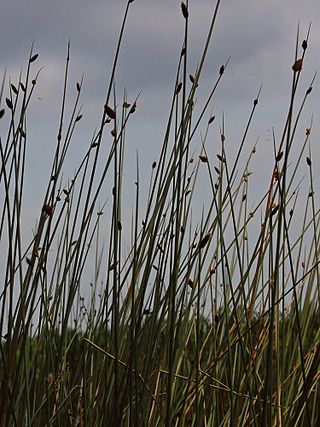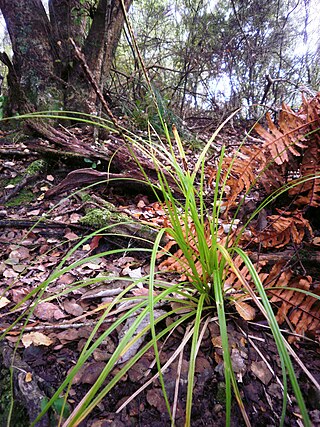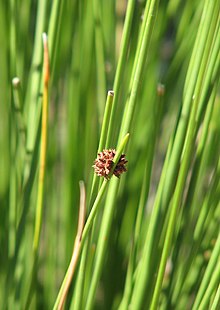
The Cyperaceae are a family of graminoid (grass-like), monocotyledonous flowering plants known as sedges. The family is large, with some 5,500 known species described in about 90 genera, the largest being the "true sedges" genus Carex with over 2,000 species.

Rhynchospora is a genus of about 400 species of sedges with a cosmopolitan distribution. The genus includes both annual and perennial species, mostly with erect 3-sided stems and 3-ranked leaves. The achenes bear a beak-like tubercule and are sometimes subtended by bristles. Many of the species are similar in vegetative appearance, and mature fruits are needed to make a positive identification.
Mapania is a genus of plants in the family Cyperaceae. It contains around 60-70 species, distributed in tropical regions of Africa, India, southern China, Southeast Asia, New Guinea, Australia, Central America, northern South America, and various oceanic islands.

Uncinia is a genus of flowering plants in the family Cyperaceae, known as hook-sedges in Australia and as hook grasses or bastard grasses in New Zealand. The genus is characterised by the presence of a long hook formed by an extension of the rachilla, which is used to attach the fruit to passing animals (epizoochory), especially birds, and it is this feature which gives the genus its name, from the Latin uncinus, meaning a hook or barb.

Lepidosperma is a genus of flowering plant of the family Cyperaceae. Most of the species are endemic to Australia, with others native to southern China, southeast Asia, New Guinea, New Caledonia and New Zealand.

Dulichium is a monotypic genus of sedge containing the single species Dulichium arundinaceum, which is known by the common name threeway sedge. This is an aquatic or semi-aquatic plant of the lakes, streams, and ponds of the United States and Canada It has a wide distribution across the two countries, though noticeably absent from the Dakotas and from the Southwestern Deserts.

Gahnia is a genus of sedges native to China, Southeast Asia, New Guinea, Australia, New Zealand and a number of Pacific Islands. The common name is due to the toothed margins. It often forms tussocks.

Kyllinga is genus of flowering plants in the sedge family known commonly as spikesedges. They are native to tropical and warm temperate areas of the world, especially tropical Africa. These sedges vary in morphology, growing to heights from 2.5 centimeters to a meter and sometimes lacking rhizomes. They are closely related to Cyperus species and sometimes treated as part of a more broadly circumscribed Cyperus.

Ficinia nodosa, the knotted club-rush or knobby club-rush, is a rhizomatous perennial in the family Cyperaceae, native to South Africa, Australia, and New Zealand. Widespread in the Southern Hemisphere, Ficinia nodosa grows to between 15 and 220 cm in height. Although it grows best in sandy, salty soil, the plant grows in a wide variety of environments from coastal sand dunes to alpine regions. F. nodosa’s appearance is characterised by dense clusters of long green stems topped with small, rounded flowers often remaining throughout the year.

Bulbostylis neglecta, neglected tuft sedge locally, is an endemic member of the Cyperaceae of Saint Helena in the South Atlantic.
Mesomelaena is a genus of sedges. It has 5 known species, all endemic to Western Australia.

Schoenoplectus pungens is a species of flowering plant in the sedge family known as common threesquare, common three-square bulrush and sharp club-rush. It is a herbaceous emergent plant that is widespread across much of North and South America as well as Europe, New Zealand and Australia.
Fimbristylis polytrichoides is a species of fimbry known by the common name rusty sedge, native to east Africa, Madagascar, China, Southeast Asia, New Guinea and Australia. The plant is common along the coast line and estuaries of Australia. The flowers are a distinctive rusty brown color appearing on a single spikelet from May to July.

Bolboschoenus is a genus of plants in the sedge family, of nearly cosmopolitan distribution. Epipaleolithic and Neolithic peoples used ground root tubers of these plants to make the first breads.

Lepironia is a genus of the sedge family, comprising only one species, Lepironia articulata, known as the grey sedge. It is found in Madagascar, India, Sri Lanka, southern China, Southeast Asia, New Guinea, and various islands of the western Pacific. It also occurs in northern and eastern Australia, as far south as Thirlmere Lakes National Park in New South Wales.

Isolepis is a cosmopolitan genus of sedge containing around 70 species. Isolepis is found in cool tropical and temperate climates often in Africa and Australasia.

Schoenus brevifolius, known as zig-zag bog-rush, is a species of sedge native to Australia, New Zealand, New Caledonia, and the Ogasawara (Bonin) Islands. It was first described by Robert Brown in 1810.

Uncinia uncinata, the Hawai'i birdcatching sedge, hook grass, hook sedge, bastard grass, kamu or matau-a-maui, is a species of flowering plant in the sedge family, Cyperaceae.

Isolepis prolifera is a species of flowering plant in the family Cyperaceae that grows in temperate regions of the Southern Hemisphere. It has leafless stems up to 90 cm (35 in) tall, and clusters of flowers that often proliferate into branches.
Cyperus pulchellus is a sedge of the family Cyperaceae that is native to northern Australia, tropical Africa, northwest Madagascar and Southeast Asia.
















